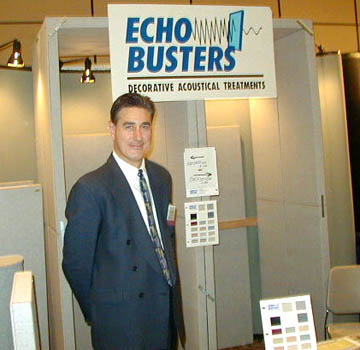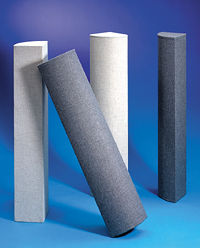|
|
= = = =
Echo Busters (this company is no longer in business, but their 2nd-hand gear is still readily available. Use the eBay links above to locate “Echo Busters” acoustical treatments. Also note that the Echo Buster products, reviewed below, are similar to several alternative commercial acoustical treatments, such as, “RoomTunes”, or “Sonex”.
Price: 4’ X 18” Echo Buster $220, 4’ x 12” Double Buster $225, 4’ x 9” radius quarter round Bass Buster $325, 4’ x 12” x 12” Phase 4 $395, 15” X 15” x 15” Corner Buster $190 pack of 4; other sizes, non-standard colors, and packages available.
= = = =

I lucked out when we moved to our new home—I got my very own private, dedicated listening room. In the room are my stereo, shelves with records and CDs, a desk with a computer, network stuff, and a printer. And my listening chair. Paradise.
But there was trouble in paradise: high ceiling at its tallest that flattens out for more than half the width of the room. But, when I cranked up the volume on the stereo, the bass was constricted, and it had a boosted midrange that included an annoyingly exaggerated cupped-hands effect. I thought the industrial-grade carpet and the window shades (not to mention all the records lining the walls) would be enough acoustic treatment. But no.
The folks at Echo Busters (Mike, and his assistant Joan, actually) were glad to help me out. I faxed them a hand- drawn diagram with the dimensions of the room, in addition to a top and a side view. They transferred this to a computer blueprint, and then we discussed my problems at length and came up with a few solutions.
CONTROLLING THE SOUND
Echo Busters offers three basic methods of controlling the sound of the listening room. The first is—and seemed rather obvious to me—sound wave absorption. The two products they offer for this are Echo Buster absorption panels (Photo 1) and Corner Buster triangular ceiling traps.
The rather lightweight Echo Buster panel is filled with flame-retardant foam and housed in a rectangular wooden frame that is meant to be hung on walls or converted to a free-standing panel. These panels are designed to absorb the sounds that reverberate around a room. These echoes, says Echo Busters, can distort and smear the soundstage.
The company claims these panels re duce the reflected sounds to produce a quieter, more revealing listening environment. Music can then be played louder with no discomfort.
The other absorption product they offer is the Corner Buster triangular ceiling trap, which is a fabric-wrapped triangular foam panel with an internal plastic diaphragm. It has beveled edges that are designed to mount into the ceiling corners. Echo Busters says that these are important because sound eventually finds its way into all corners of a room. These resonances can be terminated to treat this acoustical problem. Corner Busters mount with either Velcro or nails.
Echo Busters’ second method of controlling the sound of the listening room is bass control. The two types of products Echo Busters offers for this are Phase-4 tuning towers and Bass Busters’ low-frequency control towers.
The Phase-4 is a bass trap that has two sides of absorption and two sides of diffusion which allow—says Echo Busters—a multitude of ways to fine-tune a room. You can rotate it to achieve different acoustic benefits. Its goal is to provide control of “one-note” bass while also helping to control midrange and high frequencies. The two reflective the room was not custom built, and it sounded horrible—the cause of the problem seemed to be its sloping ceilings. The dimensions of the room are more than adequate, with an 8’ plus surfaces are made with solid laminate boards and the absorptive surfaces are perforated laminate boards with acoustical foam inside.

Above: Free-standing Echo Buster panels.
The Bass Buster control tower is de signed for corner placement with the goal of “turn acoustically bad room corners into superb high frequency diffusers.” They are designed to capture standing waves formed by sound bouncing off walls, floors, and ceilings. They claim that by removing these “boomy” low frequencies, the full bass extension that speakers are capable of producing is achieved. Bass Busters are made with a MDF (medium density fiber-board) cabinet partially filled with foam. The convex plywood front has a perforated surface that is meant to al low bass to pass through while diffusing high frequencies.
The third method of controlling sound is Echo Busters’ Double Buster, a diffusion panel. Echo Busters says that “Double Busters create the soundfield diffusion that is the hallmark of great acoustical spaces.” The Double Buster scatters sound waves to produce the so-called “disappearing walls” effect. They also absorb low frequencies, while at the same time reflecting the higher frequencies producing a “hemispherical radiation pattern.” They are meant to open up a soundstage and add dimension to the sound.
Echo Busters also makes products for noise control—that is, soundproofing. I guess these could be useful in settings where the noise from a listening room is imposing upon others. These products could be helpful to apartment dwellers, and those who share a common wall with family members who do not want to hear the current music selection of an audiophile. But Echo Busters says these products are most helpful in restaurants, schools, offices, libraries, recording studios, and the like.
AESTHETICS
Echo Busters calls these panels and the like “decorative,” but what is considered good-looking audio equipment (and all those accessories) to me and what is considered good-looking to the rest of my family are most often two completely different things. If you choose the “Acoustic Art” fabric option available on Echo Buster panels, blending into the decor of a room might be somewhat easier because of the various designs Echo Busters has to offer, but they still might be quite notice able. But in reality I suppose these panels will end up being placed in dedicated home theater or music listening rooms, not in your average living room.
They are kind of large, and even if the color or fabric design is chosen to “blend in” with the surroundings, they are likely to be noticed. But maybe I’m being a bit harsh. If located in their appropriate positions, perhaps they’ll fit in or perhaps even—God forbid—enhance their surroundings.
With so many homes’ living rooms doubling as home theaters, there is a chance that they’ll just integrate with the rest of the stuff. Although, if you follow Echo Busters’ placement recommendations, they might be noticeable not just because they are large, but be cause there will be so many of them, That said, I had no problem incorporating them into my listening room be cause, to be honest, no one really cared what they looked like—except me, and when they were all up I thought they looked pretty cool in an audiophile aficionado sort of way.
PLACEMENT
Because of my space and acoustic needs, I chose just the Echo Buster and Double Buster panels. I didn’t need any bass control panels or columns because, as I said earlier, too much or bloated bass was hardly the problem. The waveforms bouncing all over the room needed to be controlled, so I followed Echo Busters’ rule-of-thumb of deadening the front end of the listening room and livening the back end.
I started with a few panels, adding more later. The improvements in the sound of my room were incrementally positive as I added panels. I don’t want to give the impression that I simply hung the panels on my walls in accordance with Echo Busters’ plan and all was fine. I needed to experiment quite a bit, especially in regard to sidewall placement. I also was mindful not to over-damp the room, which might have been as detrimental to the sound as not having any acoustic treatment at all.
I started with two 4’ x 18” Echo Busters directly behind the front speakers (no, there aren’t any center or rear speakers). I heard an improvement just by leaning them up against the back wall. After a while, I hung them permanently with the supplied simple hardware—these panels are rather light weight and don’t need much in the way of equipment to mount them on a straight wall. The midrange calmed down a bit, and, surprisingly, some of the bass started to become more articulate—and thankfully more audible.
Next up were the side panels, which were slightly smaller 4’ x 12” panels located not just at the first reflection point along the side walls, but closer and behind the speaker on the side walls. I again heard improvements in the sound, this time not only in the mid and bass, but also the upper frequencies. Plus the soundstage came into focus.
Then the time came to mount panels on the angled walls. This was a little tricky, and took some time to get right. I ended up using “L” brackets screwed into the outer edge of the panels. There were a total of four per panel, two on each side. Finding the correct anchors to use on the thin layer of plaster over slat walls was a bit tricky, but I received some advice from one of the wandering employees at the mega-hardware store, and they were up in no time.
The panels on the angled walls had a dramatic effect on the sound. I placed two of the 4’ x 18” Echo Buster absorptive panels on the front end of the room, and two 4’ x 12” Double Buster reflective panels behind the listening position on the back end. Victory. The result of having all the panels—front, side, rear—up in the listening room made it sound as though I was in a completely different room.
The midrange anomaly that was present before the panels were up was nowhere to be found. In its place was a sound that was recording dependent, and if that recording was up to it, had a soundstage that was virtually 3-D. Between, behind, and beyond the speakers was a soundstage that I could virtually see into. With my eyes closed, with the right recording, the listening room’s walls disappeared.
Now there was bass: real, solid, tuneful, deep, gut-shaking, chest-pounding, pitch stable bass that varied little in volume throughout its frequency range. It’s as though before the panels were installed my woofers were malfunctioning. Not any more.
There’s no need to include here audiophile-reviewer nonsense or needless musical examples. Basically, what these panels did was turn a below-average- sounding listening room into at least an average-sounding one (which I’m thankful for), and maybe even an above aver age one (which it often ascends to). I can only imagine what these panels would do for a room that has “no problems”— that is, a room that a listener feels needs no acoustic treatment. I can envision that this room could soar to great heights. My room did not soar to greatness, but I sure can live with it now.
Next, I think I might try out the Bass Busters or a couple of Phase-4 units. Who knows where they will take my room? If you have the space and unautocratic decorating guidelines (that is, a sympathetic spouse), I highly recommend these products.